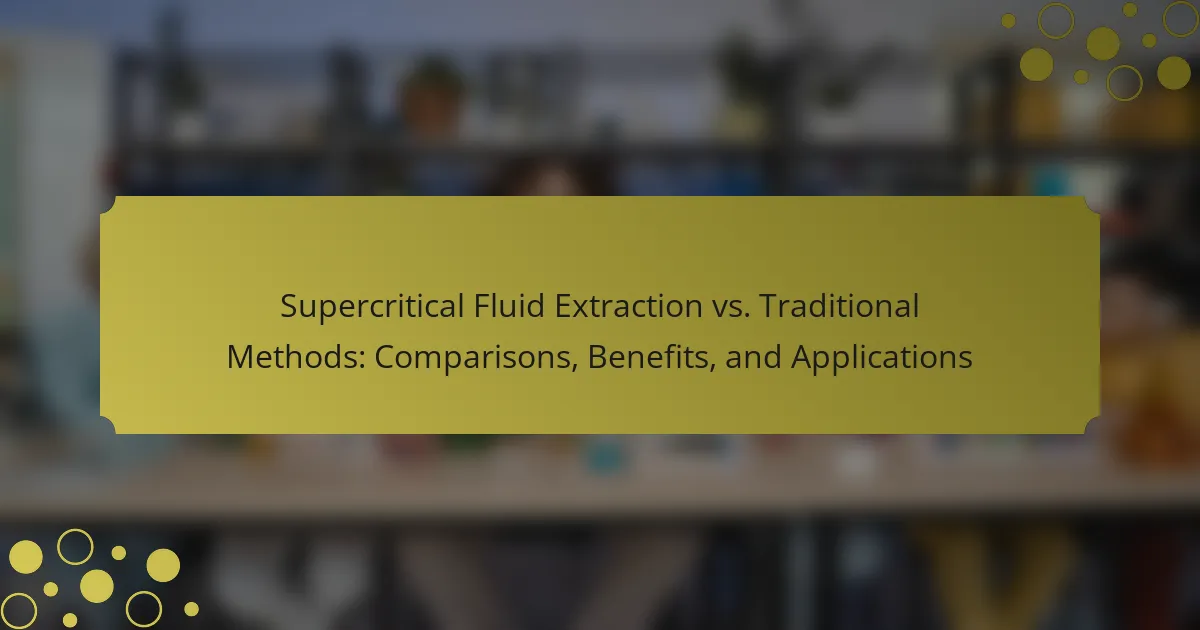Supercritical Fluid Extraction (SFE) is a method that utilizes supercritical fluids, typically carbon dioxide, to efficiently extract compounds from various materials while minimizing solvent use and degradation of sensitive substances. Recent advancements in SFE include the introduction of novel co-solvents, integration with techniques like ultrasound and microwave-assisted extraction, and improvements in equipment design, making the process more compact and energy-efficient. Despite facing challenges such as high operational costs and the need for specialized equipment, ongoing research aims to enhance the sustainability and scalability of SFE. This article explores the latest innovations, trends, and future directions in Supercritical Fluid Extraction, highlighting its applications in the food, pharmaceutical, and cosmetic industries.

What is Supercritical Fluid Extraction?
Supercritical Fluid Extraction (SFE) is a process that uses supercritical fluids to extract compounds from solid or liquid materials. Supercritical fluids are substances at a temperature and pressure above their critical point. In this state, they exhibit properties of both liquids and gases. This unique characteristic allows them to dissolve materials effectively. Common supercritical fluids include carbon dioxide due to its low toxicity and ease of removal. SFE is widely used in industries such as food, pharmaceuticals, and cosmetics. It offers advantages like reduced solvent use and lower extraction temperatures. Research shows that SFE can yield high-quality extracts with minimal degradation of sensitive compounds.
How does Supercritical Fluid Extraction work?
Supercritical Fluid Extraction (SFE) works by using supercritical fluids to extract compounds from solid or liquid matrices. A supercritical fluid is a substance at a temperature and pressure above its critical point, resulting in unique properties. In SFE, carbon dioxide is commonly used as the supercritical fluid due to its non-toxic nature and tunable solvent properties.
The process begins by pressurizing the CO2 until it reaches a supercritical state. This supercritical CO2 is then passed through the material containing the desired compounds. The supercritical fluid penetrates the material and dissolves the target compounds.
After extraction, the pressure is decreased, allowing the CO2 to return to a gaseous state. This change causes the dissolved compounds to precipitate out, separating them from the matrix. SFE is efficient and selective, often yielding higher purity extracts compared to traditional extraction methods. Studies indicate that SFE can extract bioactive compounds with minimal thermal degradation, preserving their quality.
What are the key components of Supercritical Fluid Extraction?
The key components of Supercritical Fluid Extraction (SFE) include the supercritical fluid, extraction vessel, and separation system. The supercritical fluid, often carbon dioxide, serves as the solvent. This fluid possesses unique properties, combining gas and liquid characteristics. The extraction vessel is where the material is placed for extraction. It is designed to withstand high pressure and temperature. The separation system is used to isolate the extracted compounds from the supercritical fluid. This system can include separators and condensers. Each component plays a crucial role in the efficiency and effectiveness of the extraction process.
How do pressure and temperature influence Supercritical Fluid Extraction?
Pressure and temperature are critical factors in Supercritical Fluid Extraction (SFE). They determine the solubility and diffusivity of the solute in the supercritical fluid. Higher pressure increases the density of the supercritical fluid, enhancing its solvent power. This results in improved extraction efficiency for various compounds. Conversely, increasing temperature can reduce the fluid’s density but may enhance the solubility of certain solutes.
Research indicates that optimal pressure and temperature can significantly affect extraction yields. For instance, studies show that varying pressure from 100 to 300 bar can lead to a threefold increase in extraction efficiency for specific compounds. Additionally, temperature adjustments can influence the viscosity of the fluid, impacting mass transfer rates. These interactions highlight the importance of optimizing both parameters to achieve desired extraction outcomes.
What are the primary applications of Supercritical Fluid Extraction?
Supercritical Fluid Extraction (SFE) is primarily used in the food, pharmaceutical, and cosmetic industries. In the food industry, SFE extracts flavors, fragrances, and bioactive compounds from natural sources. It is employed to obtain essential oils and natural antioxidants without thermal degradation. In pharmaceuticals, SFE is utilized to isolate active pharmaceutical ingredients efficiently. This method enhances the purity and yield of compounds while minimizing solvent use. In cosmetics, SFE extracts beneficial ingredients for skincare products. The process preserves the integrity of sensitive compounds, leading to higher-quality formulations.
Which industries utilize Supercritical Fluid Extraction?
Supercritical Fluid Extraction (SFE) is utilized in several industries. The food industry employs SFE to extract flavors and essential oils. The pharmaceutical industry uses it for extracting active compounds from plants. The cosmetic industry utilizes SFE for obtaining natural ingredients. The environmental sector applies SFE for pollutant removal from soil and water. Additionally, the cannabis industry employs SFE for extracting cannabinoids. SFE is favored in these industries for its efficiency and ability to produce high-quality extracts.
What types of materials can be extracted using Supercritical Fluid Extraction?
Supercritical Fluid Extraction (SFE) can extract a variety of materials. Commonly extracted materials include essential oils, natural flavors, and phytochemicals. SFE is also effective for extracting caffeine from coffee beans. Additionally, it is used to extract lipids and fatty acids from plant sources. Moreover, this method can isolate bioactive compounds from herbs and spices. SFE is known for its ability to extract thermally sensitive compounds without degradation. The process utilizes supercritical fluids, often carbon dioxide, for efficient extraction. These capabilities make SFE a versatile technique in various industries, including food, pharmaceuticals, and cosmetics.

What are the recent innovations in Supercritical Fluid Extraction?
Recent innovations in Supercritical Fluid Extraction (SFE) include the use of novel solvents and enhanced extraction techniques. Researchers have developed new co-solvents that improve the efficiency of extraction processes. These co-solvents can target specific compounds more effectively than traditional methods.
Another innovation is the integration of SFE with other extraction techniques, such as ultrasound and microwave-assisted extraction. This combination enhances extraction yields and reduces processing times.
Advancements in equipment design have also been significant. Modern SFE systems are now more compact, energy-efficient, and user-friendly. These improvements facilitate easier operation and maintenance in laboratory and industrial settings.
Recent studies have reported the application of SFE in extracting bioactive compounds from various natural sources, including plants and algae. This highlights the versatility of SFE in food, pharmaceutical, and cosmetic industries.
Overall, these innovations contribute to the growing adoption of Supercritical Fluid Extraction in diverse applications, enhancing both efficiency and sustainability.
How have advancements in technology improved Supercritical Fluid Extraction?
Advancements in technology have significantly improved Supercritical Fluid Extraction (SFE) by enhancing efficiency and selectivity. Modern SFE systems utilize advanced pressure and temperature control mechanisms. These innovations allow for precise manipulation of the extraction conditions. Improved automation has streamlined the extraction process. This reduces human error and increases reproducibility. Enhanced analytical techniques, such as real-time monitoring, provide immediate feedback during extraction. These advancements enable optimization of extraction parameters on-the-fly. Additionally, the development of new solvents has expanded the range of extractable compounds. Collectively, these technological improvements have made SFE more efficient and versatile in various applications.
What role do new solvents play in Supercritical Fluid Extraction?
New solvents enhance Supercritical Fluid Extraction (SFE) by improving selectivity and efficiency. These solvents can modify solubility parameters, allowing for better extraction of target compounds. For instance, the introduction of ionic liquids as solvents has shown increased extraction rates and yields in various applications. Research indicates that these new solvents can reduce extraction times significantly, optimizing the overall process. Additionally, they may enable the extraction of compounds that traditional solvents cannot effectively target. The use of new solvents also aligns with sustainability goals by reducing toxic solvent usage. Studies have demonstrated that the incorporation of these innovative solvents can lead to more environmentally friendly extraction methods.
How has automation impacted the efficiency of Supercritical Fluid Extraction?
Automation has significantly enhanced the efficiency of Supercritical Fluid Extraction (SFE). It allows for precise control over extraction parameters such as temperature, pressure, and flow rates. This precision leads to higher extraction yields and better quality of the extracted compounds. Automation reduces human error and minimizes the variability between batches. Automated systems can operate continuously, increasing throughput and reducing processing time. Studies indicate that automated SFE systems can achieve extraction efficiencies that are up to 30% higher compared to manual operations. Furthermore, automation facilitates real-time monitoring and data collection, enabling optimization of the extraction process. This integration of technology supports scalability and consistency in industrial applications.
What are the emerging trends in Supercritical Fluid Extraction?
Emerging trends in Supercritical Fluid Extraction (SFE) include the increasing use of green solvents, such as carbon dioxide. This shift aims to enhance environmental sustainability. Another trend is the miniaturization of extraction systems for lab-scale applications. Smaller systems allow for more efficient and cost-effective extraction processes. Additionally, there is a growing focus on the extraction of high-value compounds from natural sources. This includes bioactive compounds and essential oils. Advancements in automation and process control technologies are also notable. These innovations improve efficiency and reproducibility in extraction processes. Furthermore, there is an increasing integration of SFE with other extraction techniques. This hybrid approach enhances the versatility and effectiveness of extraction methods.
How is sustainability influencing Supercritical Fluid Extraction practices?
Sustainability is significantly influencing Supercritical Fluid Extraction (SFE) practices by promoting environmentally friendly methods. SFE utilizes supercritical fluids, often carbon dioxide, as solvents. This process reduces the need for harmful organic solvents, aligning with sustainability goals. The energy efficiency of SFE is also a key factor. It typically operates at lower temperatures and pressures compared to traditional extraction methods. This leads to reduced energy consumption and lower carbon emissions. Additionally, the use of renewable resources in SFE is on the rise. This shift supports sustainable sourcing of raw materials. Overall, sustainability drives innovation in SFE, leading to cleaner, more efficient extraction techniques.
What future technologies are expected to shape Supercritical Fluid Extraction?
Advanced sensors and automation are expected to shape Supercritical Fluid Extraction (SFE) in the future. These technologies will enhance process efficiency and precision. Machine learning algorithms can optimize extraction parameters in real-time. Integration of IoT devices will allow for remote monitoring and control of SFE systems. Additionally, novel supercritical fluids, such as ionic liquids, may improve extraction capabilities. Enhanced energy-efficient systems will also reduce operational costs. Research indicates that these advancements will lead to more sustainable practices in extraction processes.

What are the challenges and future directions for Supercritical Fluid Extraction?
Supercritical Fluid Extraction (SFE) faces several challenges, including high operational costs and the need for specialized equipment. The process requires precise temperature and pressure control, which can complicate scalability. Additionally, the selection of appropriate solvents is critical to achieve desired extraction efficiency. Future directions include developing more cost-effective methods and exploring alternative solvents to enhance sustainability. Innovations in technology, such as better monitoring systems, can also improve efficiency. Research indicates that advancements in supercritical fluid technology may lead to wider industrial applications, particularly in the food and pharmaceutical sectors.
What are the current limitations of Supercritical Fluid Extraction?
The current limitations of Supercritical Fluid Extraction (SFE) include high operational costs and technical complexity. SFE requires expensive equipment and maintenance, which can be a barrier for smaller operations. The process also demands precise control of temperature and pressure, complicating its implementation. Additionally, not all compounds are effectively extracted using SFE, limiting its versatility. The solubility of target compounds in supercritical fluids can vary, affecting yield. Moreover, the need for specialized knowledge and training can hinder widespread adoption. These factors collectively restrict the broader application of SFE in various industries.
How do cost factors affect the adoption of Supercritical Fluid Extraction?
Cost factors significantly influence the adoption of Supercritical Fluid Extraction (SFE). High initial investment costs deter many potential users. The equipment required for SFE is often expensive, which can limit accessibility. Additionally, operational costs, including maintenance and energy consumption, can be substantial. These costs can outweigh the perceived benefits for smaller companies or startups.
Studies show that the cost-effectiveness of SFE improves with larger-scale operations. For instance, bulk processing reduces the per-unit cost, making it more attractive for larger enterprises. Furthermore, the long-term savings on solvents and waste management can offset some initial costs.
In summary, cost factors play a critical role in determining whether organizations choose to implement SFE technology.
What regulatory challenges face Supercritical Fluid Extraction?
Supercritical Fluid Extraction (SFE) faces several regulatory challenges. One significant challenge is the lack of standardized regulations across different regions. This inconsistency complicates compliance for manufacturers operating internationally. Additionally, there are concerns regarding the safety and environmental impact of solvents used in SFE processes. Regulatory bodies often require extensive testing and documentation to ensure public safety. Another challenge is the classification of products derived from SFE, which can affect labeling and marketing. This can lead to confusion among consumers and regulatory authorities. Furthermore, evolving regulations related to food safety and pharmaceutical applications add complexity to the SFE landscape. Compliance with these regulations requires ongoing adaptation by companies in the industry.
What best practices should be followed in Supercritical Fluid Extraction?
Use high-quality solvents to ensure purity in Supercritical Fluid Extraction. CO2 is commonly preferred due to its non-toxic nature and effectiveness. Maintain optimal temperature and pressure conditions to enhance extraction efficiency. Regularly calibrate equipment for accurate measurements and consistent results. Implement proper safety protocols to handle pressurized systems. Conduct pre-extraction tests to determine the best parameters for specific materials. Monitor extraction times to avoid degradation of sensitive compounds. Document procedures and results for reproducibility and quality control. These best practices lead to improved extraction yields and product quality.
How can operators optimize the Supercritical Fluid Extraction process?
Operators can optimize the Supercritical Fluid Extraction (SFE) process by adjusting several key parameters. They should control temperature and pressure to enhance extraction efficiency. Increasing the temperature can improve solubility of target compounds. Higher pressure can increase the density of the supercritical fluid, leading to better extraction rates.
Operators can also modify the flow rate of the supercritical fluid. A higher flow rate can reduce extraction time but may compromise yield. Conversely, a lower flow rate can enhance yield but increase extraction time.
Using co-solvents can further optimize the process. Co-solvents can improve the extraction of polar compounds. This approach allows for a broader range of target compounds to be extracted effectively.
Regular maintenance of equipment is crucial for consistent performance. Clean and well-maintained systems ensure optimal flow and pressure control. This reduces downtime and enhances overall efficiency.
Finally, conducting methodical trials can help identify the best conditions for specific materials. Systematic variation of parameters can lead to improved extraction outcomes.
What common troubleshooting tips can improve Supercritical Fluid Extraction outcomes?
To improve Supercritical Fluid Extraction (SFE) outcomes, ensure optimal temperature and pressure settings. Adjusting these parameters can significantly enhance solubility and extraction efficiency. Regularly check equipment for leaks, as this can cause pressure drops and affect performance. Use appropriate co-solvents to improve the extraction of polar compounds. Monitor the extraction time, as extended periods can lead to degradation of sensitive compounds. Optimize particle size of the material being extracted to increase surface area and improve extraction rates. Lastly, maintain consistent flow rates to ensure uniform extraction conditions. These adjustments can lead to better yield and quality of extracted compounds.
Supercritical Fluid Extraction (SFE) is a technique that utilizes supercritical fluids, primarily carbon dioxide, to effectively extract valuable compounds from various materials while minimizing degradation. This article explores the fundamental workings of SFE, its key components, and its primary applications across industries such as food, pharmaceuticals, and cosmetics. It also highlights recent innovations, emerging trends, and the impact of automation and sustainability on SFE practices. Additionally, the article addresses challenges, limitations, and best practices to optimize the SFE process for improved efficiency and product quality.



